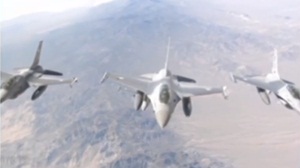India and Pakistan looked set for real conflict after Pakistan’s latest proxy war got a prompt response from India with the bombing of terrorist camps within Pakistan after a dastardly terror attack on Indian security forces by Pakistan-backed Jaishi-e-Muhammad terrorists.

While the scope for war breaking out is apparent, there is probably more chance of intervention by superpowers advising restrain as the stakes are high for both countries.
India was shaken off its slumber after a car bomb detonated by a Jaish-e-Mohammad (JeM) militant set off a car bomb that killed 46 Indian paramilitary police in Kashmir a fortnight ago.
Indian Prime Minister Narendra Modi promised a “jaw-breaking response” and he kept up his word, and it has now been delivered, knocking off several terrorists.
On Wednesday, however, the conflict between India and Pakistan escalated after Pakistan resorted to heavy shelling and retaliatory action by the Indian Army. Pakistani air force jets also crossed the Indian air space but were repulsed by the IAF.
Reports said one of the Pakistani F16 fighter jets crashed into Pakistani territory after being chased and shot by IAF aircraft. However, an Indian Air Force spokesman denied any shooting down of Pakistani aircraft and said the F-16 must have been hit by Pakistani firing
According to ANI, “Pakistan Air Force's F-16 that violated Indian air space was shot down in Indian retaliatory fire 3KM within Pakistan territory, in Lam valley, Nowshera sector.”
The SSP of Budgam said that a military aircraft crashed in J&K’s Budgam, but that details are not clear so far. ANI quoted the SSP as saying, “Some aircraft has fallen. As of now we aren't in a position to ascertain anything. Technical team is here, they'll ascertain facts. We have found 2 bodies so far and have evacuated them. Search is going on here.”
On Wednesday morning, Pakistan foreign minister Shah Mahmood Qureshi released a statement, that said, “Today, Pakistan Air Force undertook strikes across Line of Control from within Pakistani airspace. This was not a retaliation to continued Indian belligerence. Pakistan has therefore, taken strikes at non-military target, avoiding human loss and collateral damage. Sole purpose being to demonstrate our right, will and capability for self defence. We have no intention of escalation, but are fully prepared to do so if forced into that paradigm. That is why we undertook the action with clear warning and in broad daylight.”
There is no confirmation on this from the Indian defence forces or the Indian government about these strikes.
Pakistan also claimed that the Indian Air Force has violated Pakistani airspace, and that an IAF pilot has been taken into custody by them.
The Jaish-e-Mohammed (JeM) terror group claimed responsibility for the attack on the Indian troops, and have now found themselves losing some of their own. It marks the first aerial bombing in the region since the Indo-Pakistan war of 1971. While it may not be the last of the violence in this region, the latest development marks a new front in the war on terror.
The danger of escalation is obvious, and Pakistan has said it has scrambled fighter planes in response to the Indian attack. If the Indians choose not to make further bombing raids – and they have no immediate justification – or take other direct military action against the insurgents, then the tensions may subside, for now. If not, then a gradual slide into low-level warfare seems inevitable. Even that might not develop into an escalation, but, as ever in the relationship between India and Pakistan, there are other agendas at work, with China, Russia and America all interested parties in the scramble for regional influence. The Islamic Republic of Pakistan has historically been close to the US and, more recently, China; the Hindu/nationalistic India was always inclined towards friendship with Russia, and once fought a brief border war with China.
Like the Middle East, then, the scope for an accidental proxy war breaking out is apparent. However, volatile as the situation is, it is not a perfect parallel, and that should give the world some cause for hope.
But, if war breaks out between India and Pakistan, it would be a much larger one than any earlier ones.
The one deterrence could be the rise of the Indian economy, and the balance of power between the two states.































